After our wonderful days in ChinqueTerra we were off into central Italy. Franchesca chose to take the scenic route towards Tuscany and we drove along the ridge overlooking the sea, the towns and the terraced vineyards. We watched the harvest as men picked grapes and loaded them into small funiculars that brought them up to the road. In other places we watched the grapes being brought down to the road in baskets carried by the pickers.
We passed through Spezia, a larger city on the coast, and onto the motorway south and west towards Tuscany. We were talking about opera and Pavarotti, who had recently died, when we came upon Lucca, the birthplace of Puccini. On an impulse we pulled off the motorway and spent several hours walking through Lucca, eating lunch and then strolling the medieval walls. We passed a street-sweeper working- the machine was scaled down to fit the small, narrow streets.
Back onto the motorway to Greve in Chianti and arrived at the hotel, Fattoria Valle, - a 19th century manor house complete with an outdoor swimming pool.
After a short rest Francesca took us into Greve (Chianti is the name of this Italian Region) and we walked through the small town during the late afternoon and visited a ‘delicatessen’ that sold all forms of meats – many were hanging from hooks above 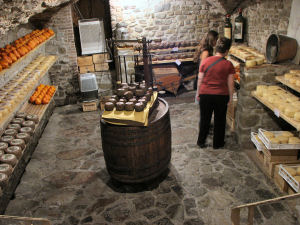
The next morning we met Francesca and, after breakfast, began a walk through the Tuscan countryside. We walked to the nearby town of Panzano where a Chianti wine festival was taking place and started our hike towards the small town of Volpaia. As we were leaving Panzano Francesca steered us into a small
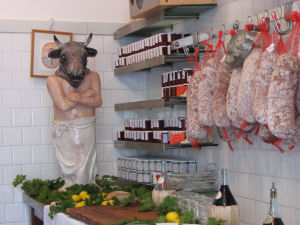
We walked out of town and down dirt roads and country lanes enjoying the expanse of the Tuscan countryside.
Fairly steep hills with what appeared to be either a small town or a castle-like structure perched on the top of each. The land was covered with acres of grape vines laden with mature San Genovese grapes ready for harvesting. In between the vineyards were groves of olive trees with an occasional patch of conifers.
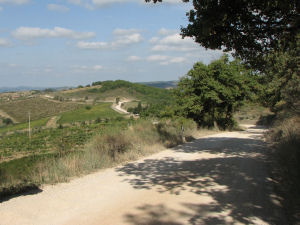
We enjoyed the sights, each other’s company and the small cat that joined our group as we neared Volpaia – after five hours of walking and nearly 6.5 miles of dirt roads.
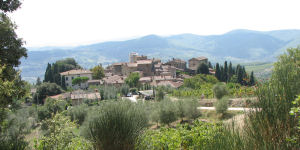
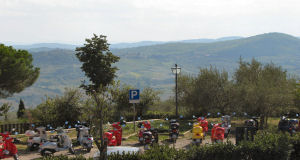
They were parked in neat rows across the length of the parking area.
Francesca took a sandwich and walked back to where she had parked the car – such service! She had parked it half-way between the towns so if Linda's feet were hurting too much or Jon’s asthma was triggered by the road dust, the car would be available. This meant that she had hiked from the car to our hotel, then with us from town to town past the parked car and, now, back halfway to pick up the auto to bring it to Volpaia. After lunch we walked through the charming medieval town.
After a rest at the hotel we went back to Panzano to participate in the Chianti Wine Tasting Festival.
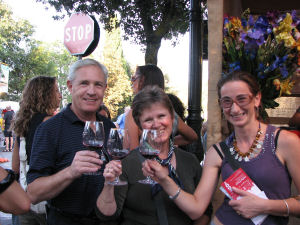
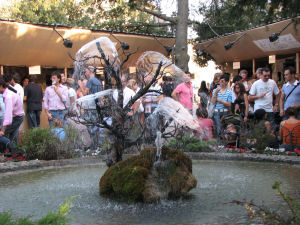
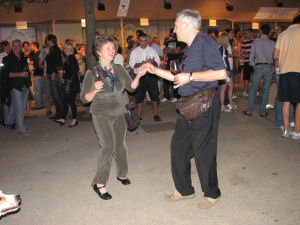
The next morning we were out early with our bags to drive to the other end of Tuscany.
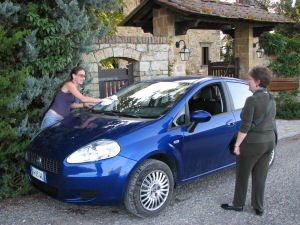
We stopped to visit San Gimignano, a remarkable 1,000 year old town that boasts a skyline of towers. Fourteen towers remain of the over 70 that once stood- each one built by a medieval family to symbolize its wealth. We enjoyed walking through the winding, narrow streets as well as climbing one of the smaller towers.
Then on to Siena, the largest city of Tuscany outside of Florence.
Most of the other Tuscan towns, during the medieval period, fought each other but eventually ended up under the control of either Florence or Siena. There are many medieval buildings fronting the narrow thousand year old streets.
We ate lunch in a park area then weandered into an open-air market, 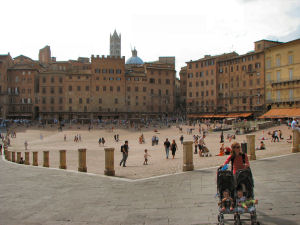
and drummers dressed in the medieval costumes that are part of the Palio.
Many of the buildings still have the symbols of the ‘unicorn counties’ – the surrounding suburbs – that vie for the privilege of participating in the horse race.
Siena is an old but comfortable city with vestiges of its medieval splendor still evident, as seen in the numerous medallions still set into the buildings.
Back into the car and off towards the Val d’Orcia and Montalcino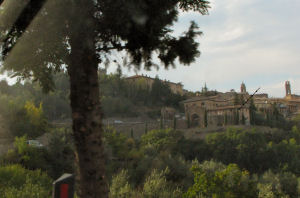 . Although we were to stay at the Vecchia Oliviera Hotel in Montalcino, Francesca drove past the town and into the countryside to the ‘agritourismo,’ Podere La Fonte run by Alberto Costagli.
. Although we were to stay at the Vecchia Oliviera Hotel in Montalcino, Francesca drove past the town and into the countryside to the ‘agritourismo,’ Podere La Fonte run by Alberto Costagli. He was a professional chef who retired and bought a farm where he takes in a small number of tourists as guests. He and his wife are friends of Francesca and Michelangelo and she had arranged
for Linda to have a cooking lesson with him.
As soon as we arrived Alberto had the two wash, put on an apron and go to work. His kitchen was small but well equipped and the restaurant area was both a working and eating area. It contains an old-style olive crusher and an olive press which Alberto uses to make his own olive oil. Outside was a large organic garden with accompanying olive trees and grape vines. He also makes his own wine.
In the kitchen Francesca was ricing potatoes in preparation for making gnocchi while Linda was working with Alberto to create “falsomagro,” a veal roll stuffed with sausage, pancetta, eggs, parsley, garlic and two types of
cheese. The whole thing was rolled and tied then cooked in a wine reduction. After pouring it on the meat Alberto took out glasses and poured wine for everyone to enjoy. While the meat was cooking Linda and Francesca made the gnocchi while Alberto created a sauce from fresh tomatoes picked from the garden. The cooking class lasted 2 ½ hours!
We then sat down, together with eight agritourismo guests, and enjoyed the meal.
Afterwards, saying “arrivederci,” we drove back to Montalcino and the hotel. It was on the edge of the town built on a steep slope and looking out over the Val d’Orcia.


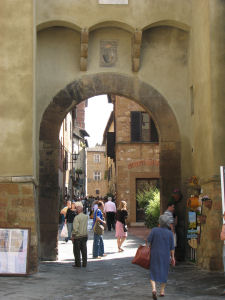
We drove to Pienza, another hilltop town. This town is characterized by its topography – it’s flat. We walked about the town and spent some time visiting with a shoemaker, Bai Sergio, who was born and raised in Pienza.
Then on to Montepulciano where, again, we wandered the streets. It’s a larger town with many tourists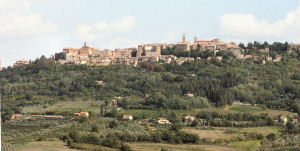

and all sorts of shops.
We visited with an artisan who was making mosaics using the centuries old method of holding a piece of glass on an axe blade set into the workbench and tapping it with a hammer to create the size and shape needed for the space. He showed us a number of mosaic pieces he was creating for a church in San Francisco.
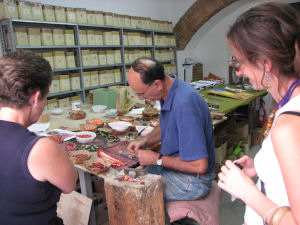
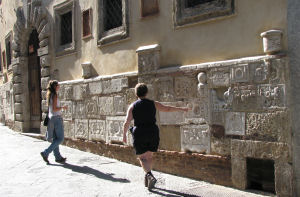
On the way back to Montalcino, Francesca called another friend who owns a winery and arranged for us to have a wine tasting. We drove down dirt roads surrounded by grape vines heavily laden with mature grapes. Diego Molinari welcomed us into his home and offered us three Brunello wines to taste.
He presses his wines from the vineyards he maintains surrounding his home. He talked with us and explained how the rain had put the grape harvest in jeopardy because grapes cannot be picked and stored while wet. When we told him of our friend in New York who is an accomplished enologist whose wines consistently win gold and silver in international competitions, Diego would not accept the idea that New York could grow good grapes for wine. We ended up purchasing two bottles of his most excellent varietals.
The next day was our last in Francesca’s company. We began our drive back to Florence and almost immediately became stuck in a traffic jam. After ten minutes Francesca suggested that we could turn around and visit an Etruscan museum that she knew. We drove to the small torn of Murlo, again situated on a hilltop. It was a quaint medieval town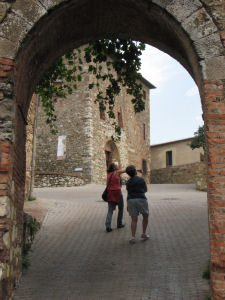
Again, on towards Florence.
As we drove into the city Francesca asked us if we were in a hurry to get to the hotel because she knew of the “best gelato in Florence.” She then spent the next 45 minutes searching for the shop because the streets had been turned into one-way since she was last there. Finally! Found it! But it was closed. So off she drove to what she called the “second best gelato in Florence.” Again we weaved through streets until she found it. Lots of traffic so Francesca parked illegally and we walked through a most unusual underground passageway to the gelateria and enjoyed the gelato.
We arrived back at the Hotel Nizza late afternoon and said our farewells to Francesca. She was an excellent guide and a delightful person.